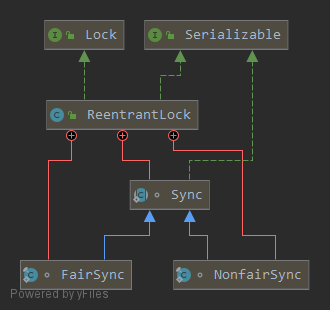ReentrantLock的实现依赖于java的同步器框架AbstractQueuedSynchronizer(AQS);
AQS使用一个整型的volatile变量(命名为state)来维护同步状态。
1、类图
2、example
public class ReentrantLockExample {int a = 0;ReentrantLock lock = new ReentrantLock(true);public void writer() {lock.lock(); //加锁try {a++;} finally {lock.unlock(); //解锁}}public void reader() {lock.lock(); //加锁try {int i = a;} finally {lock.unlock(); //解锁}}}
3、公平锁
加锁
加锁方法lock()调用轨迹如下:
- ReentrantLock :lock()。
- FairSync :lock()。
- AbstractQueuedSynchronizer :acquire(int arg)。
ReentrantLock : tryAcquire(int acquires)。
protected final boolean tryAcquire(int acquires) {final Thread current = Thread.currentThread();int c = getState(); //读volatile变量 stateif (c == 0) {if (!hasQueuedPredecessors() &&compareAndSetState(0, acquires)) { //cas更新setExclusiveOwnerThread(current); //设置互斥锁拥有线程return true;}}else if (current == getExclusiveOwnerThread()) { //重入int nextc = c + acquires;if (nextc < 0)throw new Error("Maximum lock count exceeded");setState(nextc); //写 volatile变量 satereturn true;}return false;}
解锁
解锁方法unlock()调用轨迹如下:
ReentrantLock :unlock()。
- AbstractQueuedSynchronizer : release(int arg)。
- Sync : tryRelease(int release)。
protected final boolean tryRelease(int releases) {int c = getState() - releases; //读volatile变量if (Thread.currentThread() != getExclusiveOwnerThread())throw new IllegalMonitorStateException();boolean free = false;if (c == 0) {free = true;setExclusiveOwnerThread(null); //设置互斥锁持有线程为null}setState(c); //写volatile变量return free;}
4、非公平锁
加锁
解锁



